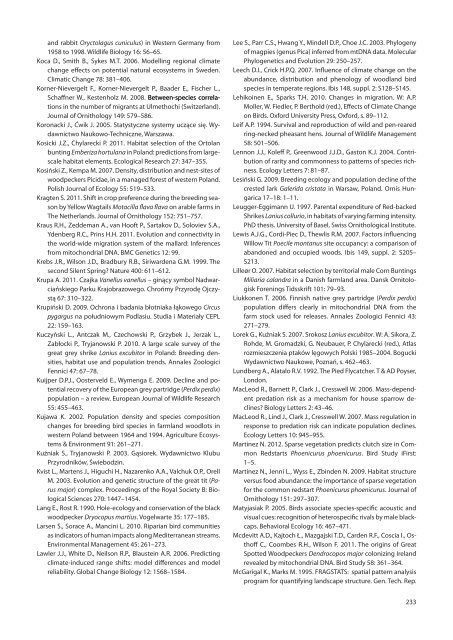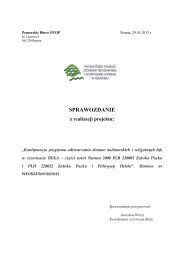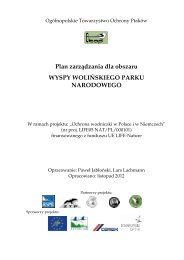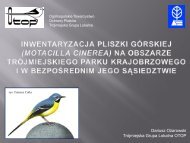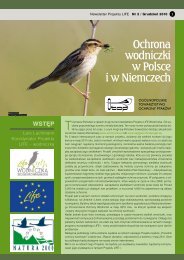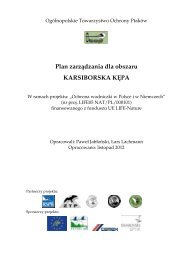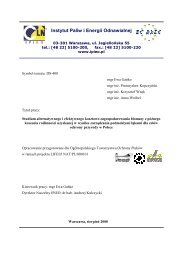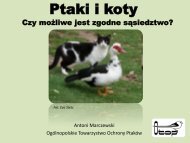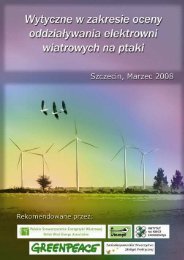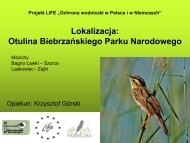Atlas pospolitych ptaków lęgowych Polski
Atlas pospolitych ptaków lÄgowych Polski
Atlas pospolitych ptaków lÄgowych Polski
- No tags were found...
You also want an ePaper? Increase the reach of your titles
YUMPU automatically turns print PDFs into web optimized ePapers that Google loves.
and rabbit Oryctolagus cuniculus) in Western Germany from<br />
1958 to 1998. Wildlife Biology 16: 56–65.<br />
Koca D., Smith B., Sykes M.T. 2006. Modelling regional climate<br />
change effects on potential natural ecosystems in Sweden.<br />
Climatic Change 78: 381–406.<br />
Korner-Nievergelt F., Korner-Nievergelt P., Baader E., Fischer L.,<br />
Schaffner W., Kestenholz M. 2008. Between-species correlations<br />
in the number of migrants at Ulmethochi (Switzerland).<br />
Journal of Ornithology 149: 579–586.<br />
Koronacki J., Ćwik J. 2005. Statystyczne systemy uczące się. Wydawnictwo<br />
Naukowo-Techniczne, Warszawa.<br />
Kosicki J.Z., Chylarecki P. 2011. Habitat selection of the Ortolan<br />
bunting Emberiza hortulana in Poland: predictions from largescale<br />
habitat elements. Ecological Research 27: 347–355.<br />
Kosiński Z., Kempa M. 2007. Density, distribution and nest-sites of<br />
woodpeckers Picidae, in a managed forest of western Poland.<br />
Polish Journal of Ecology 55: 519–533.<br />
Kragten S. 2011. Shift in crop preference during the breeding season<br />
by Yellow Wagtails Motacilla flava flava on arable farms in<br />
The Netherlands. Journal of Ornithology 152: 751–757.<br />
Kraus R.H., Zeddeman A., van Hooft P., Sartakov D., Soloviev S.A.,<br />
Ydenberg R.C., Prins H.H. 2011. Evolution and connectivity in<br />
the world-wide migration system of the mallard: Inferences<br />
from mitochondrial DNA. BMC Genetics 12: 99.<br />
Krebs J.R., Wilson J.D., Bradbury R.B., Siriwardena G.M. 1999. The<br />
second Silent Spring? Nature 400: 611–612.<br />
Krupa A. 2011. Czajka Vanellus vanellus – ginący symbol Nadwarciańskiego<br />
Parku Krajobrazowego. Chrońmy Przyrodę Ojczystą<br />
67: 310–322.<br />
Krupiński D. 2009. Ochrona i badania błotniaka łąkowego Circus<br />
pygargus na południowym Podlasiu. Studia i Materiały CEPL<br />
22: 159–163.<br />
Kuczyński L., Antczak M., Czechowski P., Grzybek J., Jerzak L.,<br />
Zabłocki P., Tryjanowski P. 2010. A large scale survey of the<br />
great grey shrike Lanius excubitor in Poland: Breeding densities,<br />
habitat use and population trends. Annales Zoologici<br />
Fennici 47: 67–78.<br />
Kuijper D.P.J., Oosterveld E., Wymenga E. 2009. Decline and potential<br />
recovery of the European grey partridge (Perdix perdix)<br />
population – a review. European Journal of Wildlife Research<br />
55: 455–463.<br />
Kujawa K. 2002. Population density and species composition<br />
changes for breeding bird species in farmland woodlots in<br />
western Poland between 1964 and 1994. Agriculture Ecosystems<br />
& Environment 91: 261–271.<br />
Kuźniak S., Tryjanowski P. 2003. Gąsiorek. Wydawnictwo Klubu<br />
Przyrodników, Świebodzin.<br />
Kvist L., Martens J., Higuchi H., Nazarenko A.A., Valchuk O.P., Orell<br />
M. 2003. Evolution and genetic structure of the great tit (Parus<br />
major) complex. Proceedings of the Royal Society B: Biological<br />
Sciences 270: 1447–1454.<br />
Lang E., Rost R. 1990. Hole-ecology and conservation of the black<br />
woodpecker Dryocopus martius. Vogelwarte 35: 177–185.<br />
Larsen S., Sorace A., Mancini L. 2010. Riparian bird communities<br />
as indicators of human impacts along Mediterranean streams.<br />
Environmental Management 45: 261–273.<br />
Lawler J.J., White D., Neilson R.P., Blaustein A.R. 2006. Predicting<br />
climate-induced range shifts: model differences and model<br />
reliability. Global Change Biology 12: 1568–1584.<br />
Lee S., Parr C.S., Hwang Y., Mindell D.P., Choe J.C. 2003. Phylogeny<br />
of magpies (genus Pica) inferred from mtDNA data. Molecular<br />
Phylogenetics and Evolution 29: 250–257.<br />
Leech D.I., Crick H.P.Q. 2007. Influence of climate change on the<br />
abundance, distribution and phenology of woodland bird<br />
species in temperate regions. Ibis 148, suppl. 2: S128–S145.<br />
Lehikoinen E., Sparks T.H. 2010. Changes in migration. W: A.P.<br />
Moller, W. Fiedler, P. Berthold (red.), Effects of Climate Change<br />
on Birds. Oxford University Press, Oxford, s. 89–112.<br />
Leif A.P. 1994. Survival and reproduction of wild and pen-reared<br />
ring-necked pheasant hens. Journal of Wildlife Management<br />
58: 501–506.<br />
Lennon J.J., Koleff P., Greenwood J.J.D., Gaston K.J. 2004. Contribution<br />
of rarity and commonness to patterns of species richness.<br />
Ecology Letters 7: 81–87.<br />
Lesiński G. 2009. Breeding ecology and population decline of the<br />
crested lark Galerida cristata in Warsaw, Poland. Ornis Hungarica<br />
17–18: 1–11.<br />
Leugger-Eggimann U. 1997. Parental expenditure of Red-backed<br />
Shrikes Lanius collurio, in habitats of varying farming intensity.<br />
PhD thesis. University of Basel, Swiss Ornithological Institute.<br />
Lewis A.J.G., Cordi-Piec D., Thewlis R.M. 2007. Factors influencing<br />
Willow Tit Poecile montanus site occupancy: a comparison of<br />
abandoned and occupied woods. Ibis 149, suppl. 2: S205–<br />
S213.<br />
Lilleør O. 2007. Habitat selection by territorial male Corn Buntings<br />
Miliaria calandra in a Danish farmland area. Dansk Ornitologisk<br />
Forenings Tidsskrift 101: 79–93.<br />
Liukkonen T. 2006. Finnish native grey partridge (Perdix perdix)<br />
population differs clearly in mitochondrial DNA from the<br />
farm stock used for releases. Annales Zoologici Fennici 43:<br />
271–279.<br />
Lorek G., Kuźniak S. 2007. Srokosz Lanius excubitor. W: A. Sikora, Z.<br />
Rohde, M. Gromadzki, G. Neubauer, P. Chylarecki (red.), <strong>Atlas</strong><br />
rozmieszczenia <strong>ptaków</strong> <strong>lęgowych</strong> <strong>Polski</strong> 1985–2004. Bogucki<br />
Wydawnictwo Naukowe, Poznań, s. 462–463.<br />
Lundberg A., Alatalo R.V. 1992. The Pied Flycatcher. T & AD Poyser,<br />
London.<br />
MacLeod R., Barnett P., Clark J., Cresswell W. 2006. Mass-dependent<br />
predation risk as a mechanism for house sparrow declines?<br />
Biology Letters 2: 43–46.<br />
MacLeod R., Lind J., Clark J., Cresswell W. 2007. Mass regulation in<br />
response to predation risk can indicate population declines.<br />
Ecology Letters 10: 945–955.<br />
Martinez N. 2012. Sparse vegetation predicts clutch size in Common<br />
Redstarts Phoenicurus phoenicurus. Bird Study iFirst:<br />
1–5.<br />
Martinez N., Jenni L., Wyss E., Zbinden N. 2009. Habitat structure<br />
versus food abundance: the importance of sparse vegetation<br />
for the common redstart Phoenicurus phoenicurus. Journal of<br />
Ornithology 151: 297–307.<br />
Matyjasiak P. 2005. Birds associate species-specific acoustic and<br />
visual cues: recognition of heterospecific rivals by male blackcaps.<br />
Behavioral Ecology 16: 467–471.<br />
Mcdevitt A.D., Kajtoch Ł., Mazgajski T.D., Carden R.F., Coscia I., Osthoff<br />
C., Coombes R.H., Wilson F. 2011. The origins of Great<br />
Spotted Woodpeckers Dendrocopos major colonizing Ireland<br />
revealed by mitochondrial DNA. Bird Study 58: 361–364.<br />
McGarigal K., Marks M. 1995. FRAGSTATS: spatial pattern analysis<br />
program for quantifying landscape structure. Gen. Tech. Rep.<br />
233


